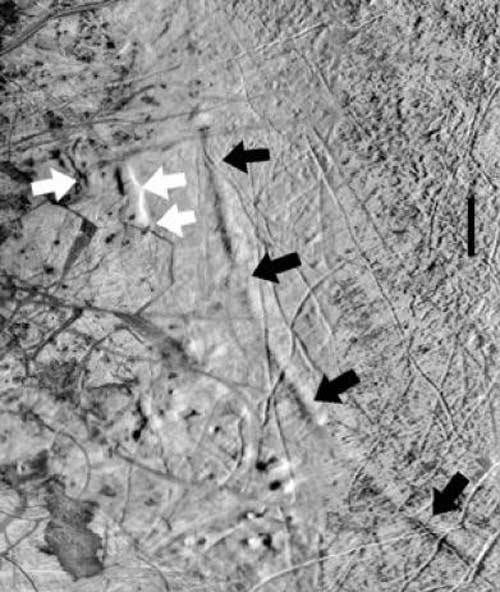Jupiter’s Moon Scarred by Wandering Poles

The meanderingpoles of Jupiter?s moon Europa etched tell-tale scars across the satellite?sicy surface, a new study finds.
Europa?sice-heavy poles shifted almost 90 degrees, from near the current equator totheir current north-south alignment, which caused the moon's spin axis tochange as well.
?A spinningbody is most stable with its mass farthest from its spin axis,? said Isamu Matsuyama,planetary scientist at the Carnegie Institution who participated in the study.?On Europa, variations in the thickness of its outer shell caused a massimbalance, so the rotation axis reoriented to a new stable state.?
Stressesfrom the changing spin axis caused fractures that stretch more than a third ofthe way across Europa's surface.
Matsuyamaand other researchers mapped arc-shaped scars extending more than 310 miles(500 km) across the Europa, using images from NASA?s Voyager, Galileo, and —more recently — the Pluto-bound New Horizons spacecraft that zipped pastJupiter last year. The Jovian moonhas a radius of just over 930 miles (1,500 km), making it slightly smaller thanEarth's moon.
Theresearch is detailed in the May 15 issue of the journal Nature.
Europajoins Earth, Mars, and Saturn's icy moon Enceladus as planetary bodies thathave experienced "true polar wander" where their spin axis shifted, Matsuyama said.
Breaking space news, the latest updates on rocket launches, skywatching events and more!
The newfinding adds more weight to the notion that Europa's icy crust slides over aliquid, subsurface ocean which could harbor conditions for life. A similarpossibility exists on Saturn'smoon Titan, leading NASA and Europe to consider futuredeep space missions to one or both places.
"Thelarge reorientation on Europa required to explain the circular depressionsimplies that its outer ice shell is decoupled from the core by a liquid layer,?Matsuyama said. ?Therefore, our studyprovides an independent test for the presence of an interior liquid layer.?
- Video: DEPTHX Robot: Europa Explorer?
- Images: Jupiter's Europa and Other Moons
- Video: Enceladus, Cold Faithful

Space.com is the premier source of space exploration, innovation and astronomy news, chronicling (and celebrating) humanity's ongoing expansion across the final frontier. Originally founded in 1999, Space.com is, and always has been, the passion of writers and editors who are space fans and also trained journalists. Our current news team consists of Editor-in-Chief Tariq Malik; Editor Hanneke Weitering, Senior Space Writer Mike Wall; Senior Writer Meghan Bartels; Senior Writer Chelsea Gohd, Senior Writer Tereza Pultarova and Staff Writer Alexander Cox, focusing on e-commerce. Senior Producer Steve Spaleta oversees our space videos, with Diana Whitcroft as our Social Media Editor.
